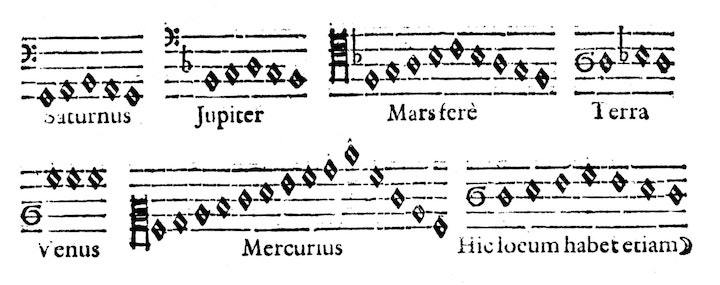15.01.2018
Citizen scientists combine to identify longest chain of synchronised exoplanets ever discovered – and best described by the language of music. Richard A Lovett reports.

With the help of citizen scientists, exoplanet hunters have made one of their most unusual discoveries yet: a system called K2-138 that contains five planets orbiting in near-perfect resonances so close to their star that all five orbits are less than 13 days.
Orbital resonances occur when planetary orbits are spaced so that they circle their star in numerically related patterns. In the case of K2-138, this resonance is close to 3:2, which means that each planet makes three circuits of the star in the time it takes the next one out to make two. That is, the outer planet’s orbit is 50% longer than the inner one’s.
Such resonances are common in the planetary systems discovered by NASA’s Kepler space telescope (which seeks exoplanets by looking for dips in the brightness of distant stars that occur when planets cross in front of them, blocking part of their light). That’s because Kepler has discovered a great many compact planetary systems, in which planets would gravitationally interfere with each other if their orbits were not somehow synchronised.
But K2-138 is the most dramatic example of this yet, with five planets — all between 1.6 and 3.3 times the size of the Earth — moving like clockwork in a succession of 3:2 resonances. Specifically, their orbits are 2.35, 3.56, 5.40, 8.26, and 12.76 days, forming an unbroken chain of close-to-3:2 resonances — the longest such chain ever discovered. Moreover, there are hints of a sixth planet, which, if it exists, would orbit in about 42 days.
That’s particularly interesting, says Jessie Christiansen, an astronomer from California Institute of Technology, Pasadena, US, who presented her findings last week at a meeting of the American Astronomical Society in National Harbor, Maryland, because 42 days falls into the same resonance chain.
That raises the possibility that there might be as-yet unobserved planets in the gaps between 12.76 days and 42. “If you continue the chain it would be 19, 27, and 42,” she says. “So it could be that the longest chain could get longer yet.”
It’s an exciting discovery, says Steve Bryson, an exoplanet-hunting astronomer at NASA Ames Research Centre at Mountain View in California, who was not a member of Christiansen’s team. “It gives us a deeper understanding of how planetary systems form.”
Christiansen agrees. The fact that the planets wound up in such a smooth arrangement, she says, suggests that they migrated inward to their present positions very sedately, rather than via chaotic gravitational interactions. “They had no fights,” she says.
It’s also intriguing because the 3:2 interval between these planets’ orbits is what musicians call a perfect fifth. “You can find them everywhere in music,” Christiansen says, citing the first two notes of Twinkle, Twinkle, Little Star as an example.
Even more interestingly, the orbits aren’t quite perfect fifths, but are just ever so slightly off, she says. That is, instead of having orbital resonances that are exactly in a 3:2 ratio (or 1.5 to 1), they are 1.513, 1.518, 1.528, and 1.544. That’s intriguing, she says, because musicians actually tune their instruments to be just slightly off from perfect-fifth intervals to avoid the irritating “beat” phenomena that happens when tuning is too perfect.
Possibly, she says, K2-138’s planets may have wound up in orbits just slightly off from perfect in order to avoid being destabilised by a similar phenomena due to too-perfect synchronisation.
But even more exciting than the science, says Bryson, is the way in which the find was made. It came via a project called Exoplanet Explorers carried out on a website called zooniverse.org.
The goal of that project, says Christiansen, is to recruit volunteers to examine any data in which the computer found a blip that might be a planet.
“They’re doing the vetting,” she says. “Looking through and saying, ‘This is junk; this is real.’
“It’s really hard to tell the computer to find everything that looks like a blip, but not ‘that’ kind of blip or ‘that’ kind of blip or ‘that’ kind of blip. So we just tell the computer to find all the blips and we’ll check.”
But with thousands of stars involved, and a desire to have at least 10 people look at everything that might be interesting, that involves a tremendous amount of person-power.
“We just uploaded 55,000 new potential planetary signals,” Christiansen says. “We would never be able to get through all of the signals we have without our volunteers.”
Meg Schwamb, an astronomer at the Gemini Observatory in Hilo, Hawaii, agrees.
“In our Internet age, online citizen science is enabling scientists to enlist the help of the general public from around the globe to perform data sorting and analysis tasks that are impossible to automate, or would be insurmountable for a single person or small group to undertake,” she says.
“With so many eyes looking at the data, these projects can find hidden gems that may have gone missed in today’s large datasets.”
“One of the things I love about astronomy,” adds Bryson, “is that it’s the one science where everyone can relate to it. Everyone knows what it’s like to look up at the stars.”
Quelle: COSMOS

